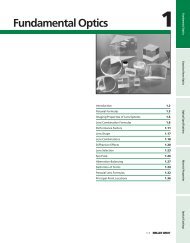Intel PXA250 and PXA210 Applications Processors
Intel PXA250 and PXA210 Applications Processors
Intel PXA250 and PXA210 Applications Processors
You also want an ePaper? Increase the reach of your titles
YUMPU automatically turns print PDFs into web optimized ePapers that Google loves.
SA-1110/<strong>Applications</strong> Processor Migration<br />
A.1.3<br />
Power Delivery<br />
Although both products are tolerant to 3.3 V inputs <strong>and</strong> outputs, there is a difference in the supply<br />
voltage that drives the transistors of the microprocessor megacell. The <strong>PXA250</strong> applications<br />
processor takes advantage of lower supply voltages to offer substantial power consumption<br />
savings. A design using SA-1110 has a supply voltage of 1.55 V to 1.75 V. The <strong>PXA250</strong><br />
applications processor is rated to 1.4 V maximum.<br />
Drive the <strong>PXA250</strong> applications processor core voltage pins at a lower voltage than the SA-1110 to<br />
reduce overall power consumption. The choice of voltage impacts the maximum upper frequency<br />
of operation so check the <strong>PXA250</strong> documentation for the correct voltages as they are application<br />
dependent.<br />
Also notice that the <strong>PXA250</strong> applications processor supports independent power sources for Core,<br />
IO, Memory Bus, phase lock loops (PLLs), <strong>and</strong> a backup battery. It is recommended that these be<br />
independent power sources.<br />
A.1.4<br />
Package<br />
The SA-1110 <strong>and</strong> the <strong>PXA250</strong> applications processors are similar but not identical. The ball pitch<br />
of 1 mm is the same <strong>and</strong> the body outlines are both 17x17 mm but the heights are different. The<br />
<strong>PXA250</strong> applications processor contains 4-layers within the package making it fractionally thicker<br />
than the SA-1110 2-layer package.<br />
When migrating to the <strong>PXA210</strong> applications processor there a few limits to functionality:<br />
• The upper 16-bits of the databus are unavailable<br />
• Only two of the primary GPIO pins are available<br />
• The upper two SDRAM bank strobes are unavailable<br />
• UART hardware flow control <strong>and</strong> external DMA are not accessible<br />
This smaller package than the SA-1110 accommodates a lower overall power envelope that may<br />
restrict upper voltage operation <strong>and</strong> maximum frequency for power consumption reasons. The ball<br />
pitch is reduced to 0.8 mm <strong>and</strong> the package is much thinner than the mBGA.<br />
A.1.5<br />
Clocks<br />
The crystal inputs for the <strong>PXA250</strong> applications processor are at the same frequency as those for the<br />
SA-1110:<br />
• High frequency input of 3.6864 MHz<br />
• Slow real-time clock source of 32.768 KHz.<br />
The input frequency requirements are relatively low, such that any crystal that is an AT-cut style<br />
with a certain amount of shunt capacitance will work for both products.<br />
The actual PLL design <strong>and</strong> process technology is different between the two products, such that a<br />
marginal SA-1110 design may not work with the <strong>PXA250</strong> applications processor. Please refer to<br />
the product specifications of each device for further details.<br />
A-4 <strong>PXA250</strong> <strong>and</strong> <strong>PXA210</strong> <strong>Applications</strong> <strong>Processors</strong> Design Guide
















